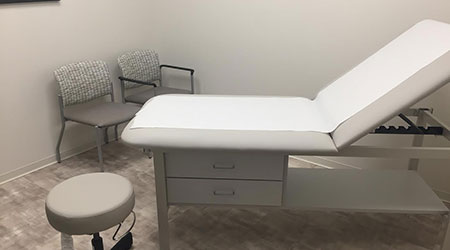The COVID-19 pandemic has had an enormous impact on the healthcare industry, and the world – emergency plans are being activated, personal protective equipment (PPE) is in short supply and temporary care sites are being constructed. Hospitals are facing an influx of patients and working hard to transform spaces to meet the demand. Here are some suggestions to help increase capacity, while being mindful of costs.
Stop/limit non-essential Procedures
Many healthcare systems have already stopped non-essential services - taking this step is critical to help prevent disease transmission to healthy patients. It also helps conserve equipment, beds, supplies and PPE that can be directed back to critical areas. Where possible, re-use furniture and fixtures like exam tables, privacy curtains, caregiver workspaces and patient seating in triage areas or temporary spaces. These items can be easily sanitized for reuse and redeployed back to their original spaces when demand drops.
Limiting services does have the consequence of reducing much-needed revenue – reusing and redeploying every resource can help mitigate the losses and conserve precious capital dollars.
Expand telehealth
Although COVID-19 is consuming resources and beds, there are many patients who still need care unrelated to the pandemic. Many have chronic conditions, need follow-up care or have health issues unrelated to COVID-19. Telehealth services are critical to keep patients who are uninfected out of urgent care and ED spaces. They can also be used to triage those patients with symptoms and reduce the load on inpatient facilities.
Carefully consider what types of patients can safely be seen and monitored remotely and ensure that any temporary telemedicine spaces meet current HIPPA requirements. Staff will need appropriate equipment – monitors, cameras, microphones, workspaces and a stable internet connection. Investing in expanding your current telehealth programs will help keep employees and patients safe, conserve resources, PPE and space - ultimately saving money.
Choose what can be reused
As patient load increases, most facilities will need some additional equipment to accommodate the growing number of cases. When existing resources and equipment have been deployed and new items are needed, ensure that items can be reused in the next time of need.
If possible, buy new items that can work within your existing furniture and equipment standards – that way any purchases can be integrated easily when things go back to normal. If you have capital dollars budgeted for later in 2020, consider spending now to avoid pent up demand and long lead times later in the year. For truly temporary items, like field beds and room dividers, look for items that are designed to be installed and removed quickly, and can be sanitized, stored and re-used for potential future waves of COVID-related cases.
Patient care items like screens, beds and chairs must be in a healthcare grade material that can easily and quickly be cleaned and disinfected. Hard, non-porous surfaces are ideal as they can be wiped quickly. For seating and other soft surfaces, a healthcare grade vinyl or TPE (thermoplastic elastomer) material provides good protection against degradation due to frequent, harsh cleaning.
Create respite spaces
Caregivers and other hospital staff are on the front lines, working long hours to keep our communities safe. They are dealing with PPE and drug shortages and may be concerned about bringing the virus home to loved ones. Ensure that staff has dedicated spaces to rest and recharge during a long and demanding shift. Provide comfortable seating, along with tables and chairs for a quick meal. The CDC recommends that these areas be completely separated from patient care spaces, with access to a restroom, storage for personal belongings and a place to take a break and eat.
Don’t forget to include all staff – Food Service, Maintenance and Environmental Services (among others) are working hard to keep spaces clean, safe and functional during this stressful time. Make sure they have comfortable, welcoming spaces to connect, receive support and decompress.
I don’t know what the healthcare world will look like when this pandemic subsides, but I have confidence that the entire healthcare community – caregivers, suppliers, administrators and designers – will come together with creative, innovative solutions that will make us all stronger. A sincere thank you to everyone that works in healthcare for the important work you are doing right now to keep us all safe.
Joanna Terry, is the director of healthcare sales at National Business Furniture

 Building Sustainable Healthcare for an Aging Population
Building Sustainable Healthcare for an Aging Population Froedtert ThedaCare Announces Opening of ThedaCare Medical Center-Oshkosh
Froedtert ThedaCare Announces Opening of ThedaCare Medical Center-Oshkosh Touchmark Acquires The Hacienda at Georgetown Senior Living Facility
Touchmark Acquires The Hacienda at Georgetown Senior Living Facility Contaminants Under Foot: A Closer Look at Patient Room Floors
Contaminants Under Foot: A Closer Look at Patient Room Floors Power Outages Largely Driven by Extreme Weather Events
Power Outages Largely Driven by Extreme Weather Events